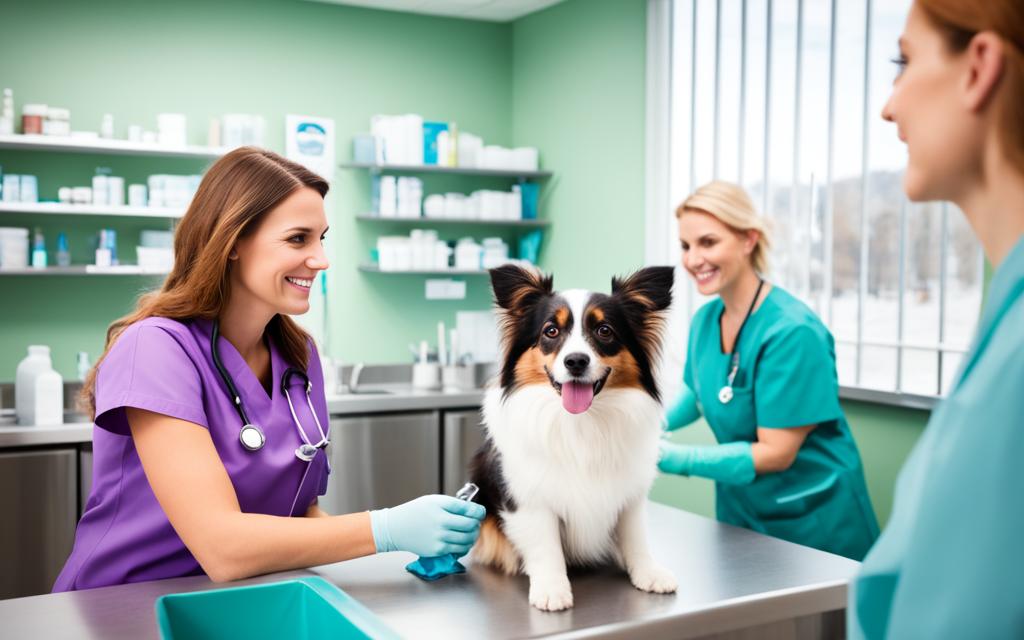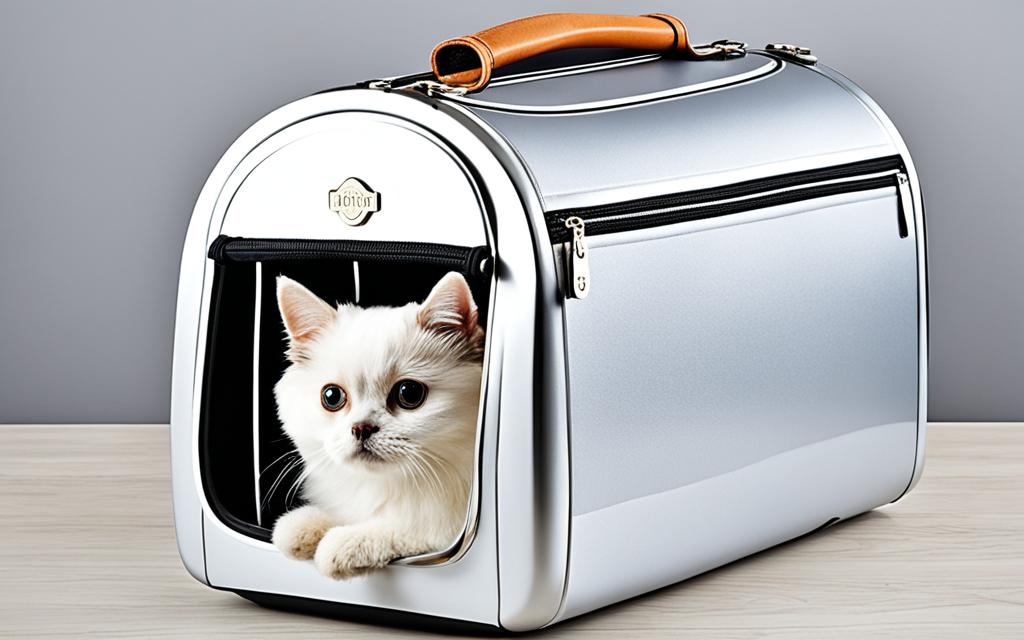We all want the very best for our pets, making sure they’re happy and healthy. Pet insurance has become a key way to achieve this. It helps cover the cost of unexpected vet bills. A recent study found that over the last month, 5,534 pet owners looked into pet insurance. This shows how important this type of insurance has become.
The top pet insurance plans are both affordable and comprehensive. They are offered by strong companies. This means you can trust they’ll be there when you need them. This article dives into the details of pet insurance. It looks at the costs, what’s covered, and other important factors to consider.
Key Takeaways
- Comprehensive pet insurance policies provide a range of coverage options, from accident-only to complete illness and wellness care.
- Factors like pet age, breed, and location can significantly impact premium costs, with monthly rates ranging from $10 to $53 on average.1
- Reimbursement rates offered by insurers typically fall between 70% and 90%, allowing pet owners to manage the financial burden of veterinary bills.1
- Pre-existing conditions and breed-specific exclusions may limit coverage, so it’s crucial to review policy details carefully.
- Discounts for multi-pet households and the claims process efficiency are important considerations when selecting a pet insurance provider.
Understanding Pet Insurance: A Comprehensive Guide
Pet insurance helps pay for your pet’s medical care, like for dogs and cats.2 It lets you handle sudden medical costs without stress, making sure your pet gets the care they need. This type of insurance often includes help with injuries, sickness, and sometimes check-ups and vaccines.
Benefits of Pet Insurance Coverage
Pet insurance is great because it stops you from facing big vet bills alone. It gives you and your pet access to top-notch care and eases your worry about the cost.3 Plus, it might cover regular check-ups, shots, and teeth cleanings, keeping your pet healthy.
Types of Pet Insurance Plans
There are different kinds of pet insurance.2 You can choose from plans that handle just accidents, only sickness, or both. Some also include extras for check-ups and preventives.
Evaluating Pet Insurance Costs
The cost of pet insurance can change a lot. It depends on the pet’s age, breed, and where you live. The level of coverage you choose matters too. Younger pets usually cost less to insure. But, older pets or those with health issues may cost more. The cost of care in your area, plus your deductible and how much you get back, also affect the price.
Factors Affecting Pet Insurance Premiums
In the U.S., pet insurance costs about $68 a month for dogs and $36 for cats on average. But, actual prices can vary a lot. This depends on where you are, your pet’s details, and the insurance company. 22 pet insurers and 10 sample pets helped find these averages.4
Average Pet Insurance Costs in the United States
Dog owners typically spend $472 a year on big vet visits. Smaller, routine check-ups add up to about $250 yearly. Cat owners pay about $232 annually for big vet visits and $198 for the regular ones.4 Pets often need medical care for things like urinary issues. Or, they might face serious problems like cancer, which costs a lot to treat.4
In 2023, over 5.6 million cats and dogs in the U.S. had insurance. This number was 17% higher than the year before. For each pet, the average yearly policy cost about $676 for dogs and $383 for cats in 2023.4
For dogs, the most common claims are for urinary issues, ear infections, and tummy troubles. Cats often need help for diabetes, throwing up, and kidney issues.4
Considerations for Pre-Existing Conditions
Pre-existing conditions in pet insurance really matter. They affect how much coverage costs and what it pays for. Usually, pet insurance won’t handle pre-existing problems. Or there might be a wait before they cover these issues.5 To know what’s what, pet owners should check their policy closely. They must tell the insurance about any health issues their pet already has.
6 Pet insurance companies usually see pre-existing conditions as able to be fixed or not. Curable ones might get covered if the pet stays well for some time, often 180 days to a year.6 Things like bladder infections, diarrhea, and ear troubles could fall into this group.
6 But things like allergies, diabetes, and heart issues are usually in the not-covered group.6 There are also ‘bilateral exclusions.’ These stop coverage for conditions affecting both sides, such as hip problems or certain tears.
6 Though, some insurers, like Pets Best or Embrace, might cover curable conditions once some time passes without symptoms or treatment.6 If a pet hasn’t shown any signs for 12 months or longer, some policies might then provide coverage.
6 Companies like ASPCA and Lemonade are easier on the rules before signing up a pet. They don’t always need a full check-up first.6 But, if there were signs of a problem before getting the insurance, that might not be covered.
5 Having a pre-existing issue doesn’t mean you can’t insure your pet. You can still get coverage for new injuries or sickness, not for the old problem.5 Preventive care is free from wait times. It includes check-ups and vaccines. But, if you were offering these just before getting insurance, it’s not covered.5 Things pets got help for in the past may also not be covered much, like wellness checks.

Choosing the Right Coverage for Your Pet
Choosing the right pet insurance means thinking about your pet’s needs and what you can afford. There are many types of coverage. For example, some plans help with accidents, while others cover illnesses. You can even add on wellness care for things like check-ups and shots.7
Accident-Only Coverage
Accident-only plans are great for sudden injuries or emergencies. They might be more budget-friendly, especially for young and healthy pets. But, these plans won’t fully protect against ongoing health issues.
Illness Coverage
Illness plans are key for helping with tests, treatments, and long-term health problems. They cover diseases and medical conditions. This kind of plan can be more inclusive than accident-only ones but might cost more.8
Wellness Care Add-Ons
Some pet insurance companies also have wellness care add-ons. These extras tackle regular visits to the vet, shots, and dental care. It’s up to you to see if these add-ons are worth the cost for your pet’s health and your wallet.
Premium Costs and Reimbursement Rates
When looking at pet insurance, it’s important to think about how much the premium costs, deductibles, and reimbursement rates are. The first source says that deductibles are out-of-pocket costs a pet owner must pay first. Co-pays are the part of the bill the owner must cover. If you pick a high deductible, your monthly premium will drop. But, you might have to pay more from your own pocket.9
Reimbursement rates differ by pet insurance provider. The second source mentions that these rates typically vary from 70% to 90%. So, pet owners might have to handle the costs of the remaining 10% to 30%. It’s smart to check the reimbursement percentages from each insurer. This way, you can find a plan that suits your budget.4
Understanding Deductibles and Co-Pays
A deductible is what the pet owner pays first. Then, the insurance kicks in. A co-pay is your share of the bill once the deductible is dealt with. Opting for a bigger deductible lowers your premium costs every month. But, you’ll pay more yourself later on.9
Comparing Reimbursement Percentages
The reimbursement rate shows how much of the bill the insurer covers. Typically, this varies from 70% to 90%. So, owners typically pay 10% to 30%. By comparing the reimbursement percentages from different insurers, you can pick a plan that fits your wallet.4

Policy Exclusions and Limitations
Pet insurance has rules you must know about. Most plans have age limits. They might not insure older pets or offer limited coverage for them. If you have an older pet, this can be a big deal. It’s good to check the details before you buy.
Age Restrictions for Pet Insurance
Age limits aren’t the only restriction. Some policies won’t cover certain breeds. These exclusions mean you might have to pay for some treatments yourself. Make sure your pet’s breed is not excluded to avoid surprises.
Breed-Specific Exclusions
Pure breeds can cost more to insure. This is because they often have more health issues.10 Covering older pets with existing conditions also costs more than for younger pets. If a pet’s condition could affect both sides, they might not cover it if one side already shows the problem.
Illnesses that vaccines could have prevented are often not covered.10 Certain breeds might not be covered for some diseases they’re prone to, like degenerative myelopathy in German Shepherds and Golden Retrievers.
Surgeries for looks, like tail docking, are usually not covered.10 Plus, some services, such as grooming, aren’t covered at all. Make sure you understand what the policy does and doesn’t cover before you sign up.
Pet Insurance Considerations
When picking a pet insurance, look at the yearly limits and payout caps. Some plans have a max on what they’ll pay yearly or over a pet’s life. This means owners might have to cover bills past these limits.11 Also, think about discounts for insuring many pets together and how easy it is to make claims.
Annual Limits and Lifetime Caps
Some policies put a cap on what they’ll pay each year or in a pet’s life. This can mean the owner has to pay more if the bills go over these limits.11
Multi-Pet Discounts
According to the third source, some insurance companies give discounts for those who insure more than one pet. These discounts lower the total cost and make insurance more affordable for families with several pets.12
Claims Process and Turnaround Time
How easy it is to claim and how fast you get money back matters a lot. The first source underlines that knowing how the company handles claims and their usual timing is key for a hassle-free reimbursement process.7

Top Pet Insurance Providers in the Market
Exploring pet insurance options, many standout providers shine in the industry.13 US News highlights 17 companies most searched by Americans. They focus on important aspects like cost and customer satisfaction. This helps pet owners find the best insurance.13
Lemonade Pet Insurance
Lemonade Pet Insurance is a top pick known for its good prices and easy online process.14 They offer plans with caps from $5,000 to $100,000 a year. You can get 70% to 90% back on covered costs. This broad range suits many pet owners wanting great protection.14
Embrace Pet Insurance
Embrace Pet Insurance also ranks high for its many coverage and discount options.14 They have policies for pets from six weeks to 14 or 15 years old. This makes them a great choice for pets of any age.14
Healthy Paws Pet Insurance
Healthy Paws is well-known for its unlimited annual coverage offer, praised in the article.13 They have high reimbursement rates and reasonable deductibles. Plus, there are no age limits for pets. Claims are processed fast, in only two work days.13
Maximizing Pet Insurance Benefits
To get the most out of pet insurance, owners should focus on preventive care and regular visits to the vet. Some plans include wellness care that pays for check-ups, shots, and teeth cleanings.15 Being proactive with your pet’s health can catch problems early. This might mean lower costs and better health in the long run.
Preventive Care and Routine Visits
Wellness plans can cut the cost of regular care. Know what terms like premium, deductible, and maximum coverage mean.16 This can help you make the most of your insurance. Also, check different types of plans to find what fits your pet’s needs and your budget.
Managing Chronic Conditions
If your pet has a chronic health issue, managing it is crucial. Pet insurance can help pay for ongoing care like medicine and vet visits.16 Working with your vet and understanding your policy can make sure your furry friend gets the care it needs without a big financial hit.

Conclusion
Finally, pet insurance is a smart buy. It gives pet owners peace of mind. Plus, it helps with big vet bills.
There are many types of plans to choose from. The cost of each plan varies1718. So does what they cover and what they don’t handle. Understanding these bits helps you pick the perfect plan for your pet and your wallet.
The article shared tips on picking the right insurance provider. It also dove into how to get the most from your coverage. In the U.S., only a small percentage of pets are insured. This shows there’s room for more growth in the industry19.
Getting the right pet insurance helps greatly. It means your pets get care without you stressing over the cost. Pet insurance is linked to higher veterinary spending. This is good news. It means pet owners with insurance are more likely to tackle their pets’ health problems. A good plan lets you focus on your furry friends. It gives you the backup for any surprise vet bills.
FAQ
What is pet insurance?
What are the key benefits of pet insurance coverage?
What are the main types of pet insurance plans?
How much does pet insurance cost?
How do pre-existing conditions impact pet insurance coverage?
What should pet owners consider when choosing a pet insurance policy?
What are some important considerations regarding policy exclusions and limitations?
What other factors should pet owners consider when evaluating pet insurance policies?
What are some of the top pet insurance providers in the market?
How can pet owners maximize the benefits of pet insurance?
Source Links
- https://apnews.com/buyline-personal-finance/article/how-does-pet-insurance-work
- https://www.nerdwallet.com/article/insurance/pet-insurance-coverage
- https://content.naic.org/sites/default/files/publication-pin-op-pet-insurance.pdf
- https://www.nerdwallet.com/article/insurance/is-pet-insurance-worth-it
- https://www.aspcapetinsurance.com/research-and-compare/pet-insurance-basics/pet-insurance-and-pre-existing-conditions/
- https://www.forbes.com/advisor/pet-insurance/pet-pre-existing-conditions/
- https://www.aaha.org/resources/pet-insurance/how-do-i-choose-the-right-pet-insurance/
- https://petinsuranceinfo.com/plans-and-policies/choosing-a-plan
- https://www.marketwatch.com/guides/pet-insurance/pet-insurance-cost/
- https://www.investopedia.com/what-is-not-covered-by-pet-insurance-5077294
- https://www.insurance.ca.gov/01-consumers/105-type/8-pet/pet-qa.cfm
- https://www.aspcapetinsurance.com/resources/pet-insurance-buyers-guide/
- https://www.usnews.com/insurance/pet-insurance
- https://www.nerdwallet.com/article/insurance/best-pet-insurance-companies
- https://cats.com/pet-insurance-benefits
- https://walnutcreekvethospital.com/pondering-pet-insurance-factors-to-consider-before-purchasing-a-policy/
- https://pawscanada.ca/blog/understanding-pet-insurance-practical-suggestions/
- https://www.pethonesty.com/blogs/blog/is-pet-insurance-worth-it
- https://www.ncbi.nlm.nih.gov/pmc/articles/PMC7401533/
